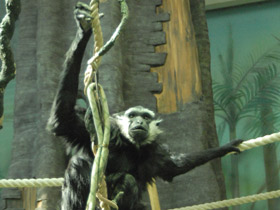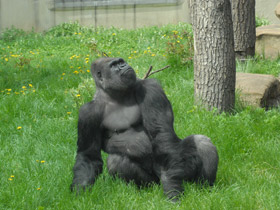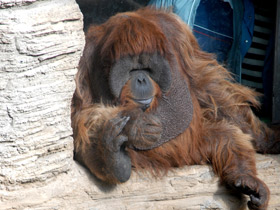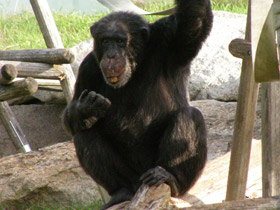The clade Apes (collectively Hominoidea)
Apes (collectively Hominoidea /hɒmɪˈnɔɪdi.ə/) are a clade of Old World simians native to sub-Saharan Africa and Southeast Asia (though they were more widespread in Africa, most of Asia, and Europe in prehistory), which together with its sister group Cercopithecidae form the catarrhine clade, cladistically making them monkeys. Apes do not have tails due to a mutation of the TBXT gene. In traditional and non-scientific use, the term ape can include tailless primates taxonomically considered Cercopithecidae (such as the Barbary ape and black ape), and is thus not equivalent to the scientific taxon Hominoidea. There are two extant branches of the superfamily Hominoidea: the gibbons, or lesser apes; and the hominids, or great apes.
The family Hylobatidae, the lesser apes, include four genera and a total of 20 species of gibbon, including the lar gibbon and the siamang, all native to Asia. They are highly arboreal and bipedal on the ground. They have lighter bodies and smaller social groups than great apes.
The family Hominidae (hominids), the great apes, include four genera comprising three extant species of orangutans and their subspecies, two extant species of gorillas and their subspecies, two extant species of panins (bonobos and chimpanzees) and their subspecies, and humans in a single extant subspecies.
Except for gorillas and humans, hominoids are agile climbers of trees. Apes eat a variety of plant and animal foods, with the majority of food being plant foods, which can include fruits, leaves, stalks, roots and seeds, including nuts and grass seeds. Human diets are sometimes substantially different from that of other hominoids due in part to the development of technology and a wide range of habitation. Humans are by far the most numerous of the hominoid species, in fact outnumbering all other primates by a factor of several thousand to one.
All non-human hominoids are rare and threatened with extinction. The eastern hoolock gibbon is the least threatened, only being vulnerable to extinction. Five gibbon species are critically endangered, as are all species of orangutan and gorilla. The remaining species of gibbon, the bonobo, and all four species of chimpanzees are endangered. The chief threat to most of the endangered species is loss of tropical rainforest habitat, though some populations are further imperiled by hunting for bushmeat. The great apes of Africa are also facing threat from the Ebola virus. Currently considered to be the greatest threat to survival of African apes, Ebola infection is responsible for the death of at least one third of all gorillas and chimpanzees since 1990.
Taxonomic classification and phylogeny
Genetic analysis combined with fossil evidence indicates that hominoids diverged from the Old World monkeys about 25 million years ago (mya), near the Oligocene–Miocene boundary. The gibbons split from the rest about 18 mya, and the hominid splits happened 14 mya (Pongo), 7 mya (Gorilla), and 3–5 mya (Homo & Pan). In 2015, a new genus and species were described, Pliobates cataloniae, which lived 11.6 mya, and appears to predate the split between Hominidae and Hylobatidae.
The families, and extant genera and species of hominoids are:
Superfamily Hominoidea
Family Hominidae: hominids ("great apes")
- Genus Pongo: orangutans
- Bornean orangutan, Pongo pygmaeus
- Sumatran orangutan, Pongo abelii
- Tapanuli orangutan, Pongo tapanuliensis
- Genus Gorilla: gorillas
- Western gorilla, Gorilla gorilla
- Eastern gorilla, Gorilla beringei
- Genus Homo: humans
- Human, Homo sapiens
- Genus Pan: chimpanzees
- Chimpanzee, Pan troglodytes
- Bonobo, Pan paniscus
- Family Hylobatidae: gibbons ("lesser apes")
- Genus Hylobates
- Lar gibbon or white-handed gibbon, H. lar
- Bornean white-bearded gibbon, H. albibarbis
- Agile gibbon or black-handed gibbon, H. agilis
- Western grey gibbon or Abbott's grey gibbon, H. abbotti
- Eastern grey gibbon or northern grey gibbon, H. funereus
- Müller's gibbon or southern grey gibbon, H. muelleri
- Silvery gibbon, H. moloch
- Pileated gibbon or capped gibbon, H. pileatus
- Kloss's gibbon or Mentawai gibbon or bilou, H. klossii
- Genus Hoolock
- Western hoolock gibbon, Hoolock hoolock
- Eastern hoolock gibbon, Hoolock leuconedys
- Skywalker hoolock gibbon, Hoolock tianxing
- Genus Symphalangus
- Siamang, Symphalangus syndactylus
- Genus Nomascus
- Northern buffed-cheeked gibbon, Nomascus annamensis
- Black crested gibbon, Nomascus concolor
- Eastern black crested gibbon, Nomascus nasutus
- Hainan black crested gibbon, Nomascus hainanus
- Southern white-cheeked gibbon Nomascus siki
- White-cheeked crested gibbon, Nomascus leucogenys
- Yellow-cheeked gibbon, Nomascus gabriellae.
Characteristics
Like those of the orangutan, the shoulder joints of hominoids are adapted to brachiation, or movement by swinging in tree branches.
The lesser apes are the gibbon family, Hylobatidae, of sixteen species; all are native to Asia. Their major differentiating characteristic is their long arms, which they use to brachiate through trees. Their wrists are ball and socket joints as an evolutionary adaptation to their arboreal lifestyle. Generally smaller than the African apes, the largest gibbon, the siamang, weighs up to 14 kg (31 lb); in comparison, the smallest "great ape", the bonobo, is 34 to 60 kg (75 to 132 lb).
The superfamily Hominoidea falls within the parvorder Catarrhini, which also includes the Old World monkeys of Africa and Eurasia. Within this grouping, the two families Hylobatidae and Hominidae can be distinguished from Old World monkeys by the number of cusps on their molars; hominoids have five in the "Y-5" molar pattern, whereas Old World monkeys have only four in a bilophodont pattern.
Further, in comparison with Old World monkeys, hominoids are noted for: more mobile shoulder joints and arms due to the dorsal position of the scapula; broader ribcages that are flatter front-to-back; and a shorter, less mobile spine, with greatly reduced caudal (tail) vertebrae—resulting in complete loss of the tail in extant hominoid species. These are anatomical adaptations, first, to vertical hanging and swinging locomotion (brachiation) and, later, to developing balance in a bipedal pose. Note there are primates in other families that also lack tails, and at least one, the pig-tailed langur, is known to walk significant distances bipedally. The front of the ape skull is characterised by its sinuses, fusion of the frontal bone, and by post-orbital constriction.
Distinction from monkeys
Cladistically, apes, catarrhines, and extinct species such as Aegyptopithecus and Parapithecidaea, are monkeys, so one can only specify ape features not present in other monkeys.
Unlike most monkeys, apes do not possess a tail. Monkeys are more likely to be in trees and use their tails for balance. While the great apes are considerably larger than monkeys, gibbons (lesser apes) are smaller than some monkeys. Apes are considered to be more intelligent than monkeys, which are considered to have more primitive brains.
The enzyme urate oxidase has become inactive in all apes, its function having been lost in two primate lineages during the middle Miocene; first in the common ancestors of Hominidae, and later in the common ancestor of Hylobatidae. It has been hypothesized that in both incidents it was a mutation that occurred in apes living in Europe when the climate was getting colder, leading to starvation during winter. The mutation changed the biochemistry of the apes and made it easier to accumulate fat, which allowed the animals to survive longer periods of starvation. When they migrated to Asia and Africa, this genetic trait remained.
Behaviour
Major studies of behaviour in the field were completed on the three better-known "great apes", for example by Jane Goodall, Dian Fossey and Birute Galdikas. These studies have shown that in their natural environments, the non-human hominoids show sharply varying social structure: gibbons are monogamous, territorial pair-bonders, orangutans are solitary, gorillas live in small troops with a single adult male leader, while chimpanzees live in larger troops with bonobos exhibiting promiscuous sexual behaviour. Their diets also vary; gorillas are foliovores, while the others are all primarily frugivores, although the common chimpanzee hunts for meat. Foraging behaviour is correspondingly variable.
Diet
Apart from humans and gorillas, apes eat a predominantly frugivorous diet, mostly fruit, but supplemented with a variety of other foods. Gorillas are predominantly folivorous, eating mostly stalks, shoots, roots and leaves with some fruit and other foods. Non-human apes usually eat a small amount of raw animal foods such as insects or eggs. In the case of humans, migration and the invention of hunting tools and cooking has led to an even wider variety of foods and diets, with many human diets including large amounts of cooked tubers (roots) or legumes. Other food production and processing methods including animal husbandry and industrial refining and processing have further changed human diets. Humans and other apes occasionally eat other primates. Some of these primates are now close to extinction with habitat loss being the underlying cause.
Cognition
All the non-human hominoids are generally thought of as highly intelligent, and scientific study has broadly confirmed that they perform very well on a wide range of cognitive tests—though there is relatively little data on gibbon cognition. The early studies by Wolfgang Köhler demonstrated exceptional problem-solving abilities in chimpanzees, which Köhler attributed to insight. The use of tools has been repeatedly demonstrated; more recently, the manufacture of tools has been documented, both in the wild and in laboratory tests. Imitation is much more easily demonstrated in "great apes" than in other primate species. Almost all the studies in animal language acquisition have been done with "great apes", and though there is continuing dispute as to whether they demonstrate real language abilities, there is no doubt that they involve significant feats of learning. Chimpanzees in different parts of Africa have developed tools that are used in food acquisition, demonstrating a form of animal culture.














































